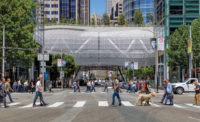Facebook's Gehry-Designed Headquarters Opens for Business














The start-up culture of Silicon Valley, nurtured in a variety of ad-hoc spaces, has spawned a trendy, DIY-style of interior architecture. Facebook’s first ground-up office building, which opened its doors at the end of March, attempts to recreate that converted-warehouse ethos on a grand corporate scale. Designed by Frank Gehry, the 430,000-square-foot building has an endearing gawkiness, a mashed-up quality that doesn’t read “office.” Announcing its recent opening on his personal Facebook page, CEO Mark Zuckerberg said, “The building itself is pretty simple and isn’t fancy. That’s on purpose. We want our space to feel like a work in progress.”
Located on the edge of the San Francisco Bay alongside a major expressway, the building is very visible to commuters. While Facebook has not yet released official images of the prosaically named MPK20 (building No. 20 in the suburban town of Menlo Park), snapshots on social media show its lofty interiors (the company claims it is the world’s largest open-plan office) with exposed concrete and plywood elements, art-installation interludes, and multiple glass-walled lobbies. At lunchtime, some of the 2,800 occupants can be seen riding pale-blue company bikes between the old campus and the new building, as well as hiking up the dozen or so exterior staircases to the 9-acre rooftop park.
Granted, MPK20 doesn’t have to do much to stand out among Silicon Valley’s banal office parks, and it doesn’t challenge the
low-rise suburban model. But as the first building to be finished by one of the area’s tech heavyweights (Apple’s new headquarters is currently under construction, and Google has only recently unveiled plans for headquarters designed by Bjarke Ingels and Thomas Heatherwick), it has moved the ball forward in a few significant ways. All the parking is at-grade underneath the building, which immediately densifies the site; the glass curtain walls are clear instead of obscured by black reflective coating; and it meets the public sphere squarely, sharing a major intersection and a combined pedestrian and bike tunnel. This interface is not an easy thing to figure out; guards are on hand to turn non-employees away from a small corner park, and the much-publicized rooftop park is all but invisible to the surrounding community. However, in its next phases of expansion, Facebook has plans for a 5-acre public park and employee housing. With so many resources at their disposal, Facebook and other tech giants have the ability to build company towns complemented by public amenities—hopefully with an MPK20 sense of playfulness.









